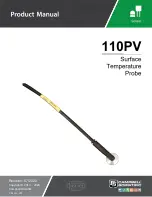
8
English
Therm.1
Switches the pump off after
exceeding the permissible
temperature value. After
cooling down the pump is
ready to work (chapter 3).
Therm.2
Switches the pump off after
exceeding the permissible
temperature value. The
pump can be restarted after
cooling down the pump and
after the failure has been
accepted (chapter 3).
If no thermal protection is
connected to terminals 21,
22, the terminals shall be
bridged.
2.2.2. Control and signal circuit terminals
Connection terminals of:
•
float switches
• thermal protections
•
external level sensor
NOTE!
All connections must be
made at
non-potential status. De-
livery of external voltage
to any of the connectors
may result in damage to
the controller.
Alarm relay contact termi-
nals:
•
terminals 1, 2 – 12V DC
potential contacts
•
terminals 3 to 6 –
non-potential contacts
2.3. Level measurement
MR-Lift is equipped with 2 methods for measur-
ing the level of liquid in the tank – linear meas
-
urement (internal sensor or external pressure
sensor 4-20mA) and float switches.
2.3.1. Linear level measurement
Measurement of water column pressure in the
range 0 - 100cm.
If the pump is operating in an
explosive atmos-
phere
, the pump station must be equipped with a
float indicating lack of liquid. Remove the jumper
from the
NL
input and connect the float. In case
of lack of liquid the display shows “No liquid”, the
alarm will sound and the pump will be stopped.
When using a
screw pump
the pump station also
must be equipped with a float indicating lack of
liquid.
2.3.1.1. Internal sensor
Connect pressure line of diameter 8x6 mm to
the metal connector on the right of the device.
Required pressure can be obtained by use of one
of the following methods:
1. Closed cast iron bell hung in the tank.
2.
Sparge pipe method: tube or iron bell placed in
the tank, supplied with bubbles generated by the
membrane pump.
2.3.1.2. External pressure sensor 4-20mA
External two-wire sensor must be connected to
terminals 30 (+) i 31 (-). The sensor is powered by
stabilized voltage of 20V.
2.3.2. Float switches
Float inputs work as normally open.
Operation with 2
float switches
Operation with 3
float switches
Operation with 3
float switches on
a single wire
Choose the “floats” option from the level meas
-
urement menu. The display shows the status of all
three contacts: NL, SW, HL. The SW float turns the
pump on and off and its hysteresis determines
the difference between the level of turning the
pump on and off. The HL float indicates a high
level. The NL float indicates a lack of liquid. If the
pump is operating in an explosive atmosphere,
the pump station must be equipped with a float
indicating lack of liquid. When using a screw
pump the pump station also must be equipped
with a float indicating lack of liquid.
If an inappropriate status occurs (e.g.
NL
=0,
SW
=1), the alarm is turned on and the follow
-
ing message is displayed: “Float switches wrong
sequence”. Check the status, remove its cause
and accept the alarm. This alarm does not result
in blocking the pump’s start and the pump will
work despite failures of float switches. The
HL
float turns the pump on immediately, regardless
of floats
SW
. It must be noted that the high level
float switch terminal is always active, even if
another method of level measurement has been
chosen from the menu.
2.4. Test run without pump
To check working of the control system with no
pump connected, proceed in accordance with the
following instructions:
1.
Turn the power supply on (it is enough to connect
L1, N, PE).
2.
From the menu set “Maximum current” to 0.0A.
Otherwise an alarm will occur and the message
“No load” will be displayed.
3. From the menu turn off the “Therm.protect1”.
Otherwise an alarm will occur and the message
“Thermal fault 1” will be displayed.
4. Close terminals 21, 22. Otherwise an alarm will
occur and the message “Thermal fault 2” will
occur.






































